On View
Why an Artist and a Scientist Teamed Up to Bring the Sounds of the Undersea World Into the Heart of Miami’s Art Fair Week
Jana Winderen and Tony Myatt's work 'The Art of Listening: Under Water' is at Collins Park in Miami.
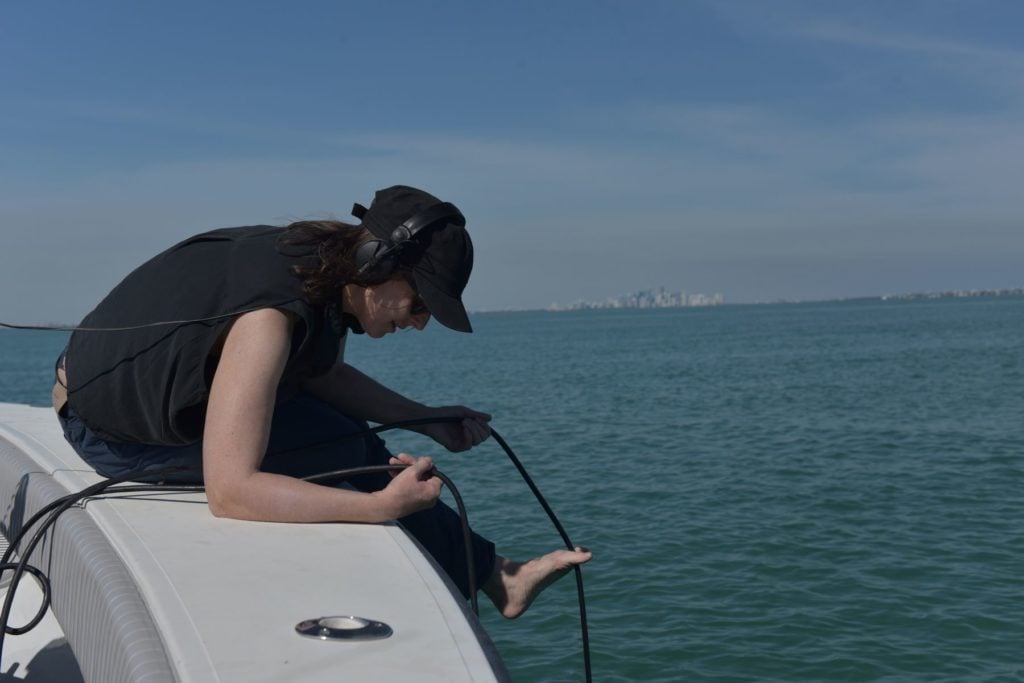
Jana Winderen and Tony Myatt's work 'The Art of Listening: Under Water' is at Collins Park in Miami.

Tim Schneider

If you’ve visited Collins Park during Art Basel Miami Beach this week, you’ve undoubtedly seen banners for The Art of Listening: Under Water, a spatial sound installation by Norwegian artist Jana Winderen and her collaborator Tony Myatt that turns the park’s rotunda into a sonic gateway to the seldom-heard marine ecosystem.
Commissioned by Swiss timepiece titan Audemars Piguet, the work is a sort of sequel—or perhaps the next evolution—of a piece Winderen created for this June’s edition of Art Basel in the mega-fair’s namesake city. But whereas the earlier piece focused on the sounds of Switzerland’s Jura Mountains, the new piece makes the sea’s natural wonders and man-made stresses surprisingly visceral for locals and visitors alike.
With the climate crisis percolating beneath nearly every aspect of the week’s festivities, Winderen and Myatt sat down with Artnet News to discuss how to make an invisible crisis visible, the importance of reconnecting with our lost past, and how Jacques Cousteau lied to us all. (The conversation has been condensed and edited for clarity.)
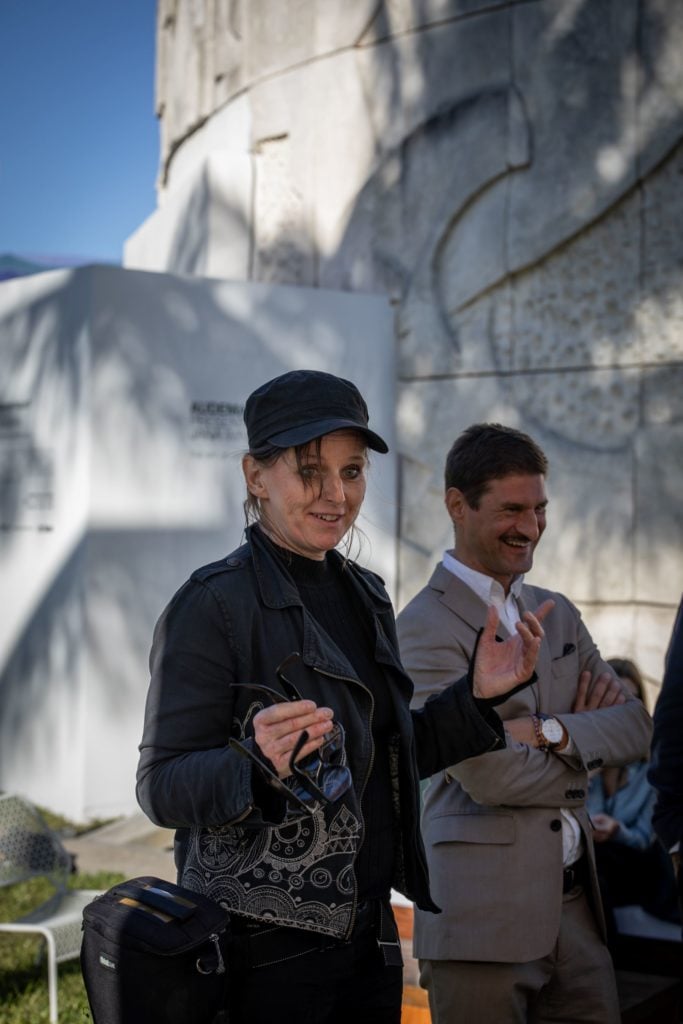
Artist Jana Winderen and Denis Pernet, Audemars Piguet Associate Curator, at the opening of “The Art of Listening: Under Water” by Jana Winderen at Art Basel Miami Beach, 2019. Courtesy of the artist and Audemars Piguet.
What was the origin of this project?
JW: This is a commission by Audemars Piguet, and I was invited to come up in the Jura Mountains to visit near the factory. I was particularly interested in a 300-year-old forest up there, with trees that are looked after very much for their excellent resonating capacity. Their wood is used for violins and cellos.
I had also worked with a project in Thailand where you could listen to the underwater environment using an oar [pressed] to the head. And through that project, I became very aware of how different types of wood would transmit sound from water to air. So when I came up [to the Jura Mountains], I also had in mind the local fish in the lake. It was under attack by a lot of human-created sound. It looks very beautiful, but there’s a totally different story when you put a microphone out.
I made this piece for Art Basel in Basel, and while we were working on it, Audemars Piguet suggested that we [do] a project in the rotunda [at Collins Park in Miami]. And then I suggested that we would like to do something site-specific having to do with Miami Beach and the ocean right outside. I like things to be based in the local and the recognizable, so that people can have a relationship to the sounds and to the site. You may be dealing with a global issue, but [having] the local sounds give people a feeling that it’s actually present here.
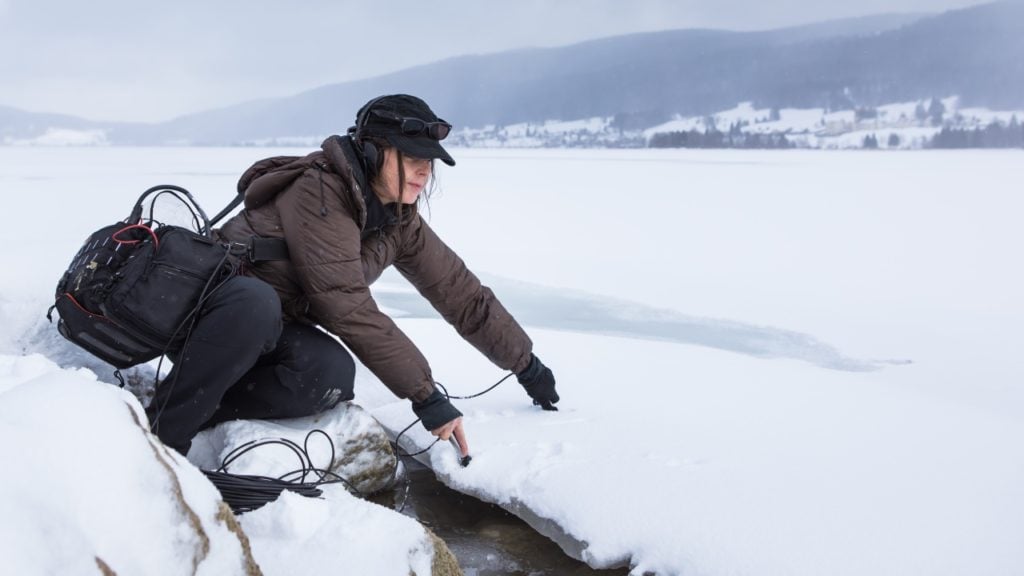
Jana Winderen recordings sounds in the Vallée de Joux. Courtesy the artist and Audemars Piguet.
How did you go about creating the piece?
JW: Tony and I together went out to record locally. I was expecting to get a lot of human sounds from the harbor here, close to land. And I had already prepared a lot of the sound and the story, which would be about coming from the north, where the ice is melting, to here, the south, where you get the flooding. So the storyline of the work was already made, but I knew [it would be affected by] the temperature outside, the situation you come from, the sound environment you leave, and the closeness to the sea.
In my experience, people tend to not think about sound in the same types of way that they think about images. Tony, as an academic, can you speak to the aspects of sound that the average person might not appreciate until you shape it in a particular way?
TM: Well, I think there are two parts to that. One is that listening is something we’re training ourselves not to do a lot of the time. We try not to hear background noise: cars, sirens, the music that’s being played in bars and cafes, and so on. We’re trying to tune into our own conversations whilst making it very difficult for ourselves to do that by creating all of the background noise that can obfuscate the sounds we make.
Jana obviously has a great interest in underwater recording, and part of my role here is to work with her from the recording stage through to the production stage to create these environments that are believable and understandable. And listening underwater, which is the subject here, is something that people can’t do. We don’t have the physical mechanism to do it, we don’t have the size of head to do it, and we don’t have any way to perceive the spatial world underwater. And the oceans are the most sound-rich environments on the planet.
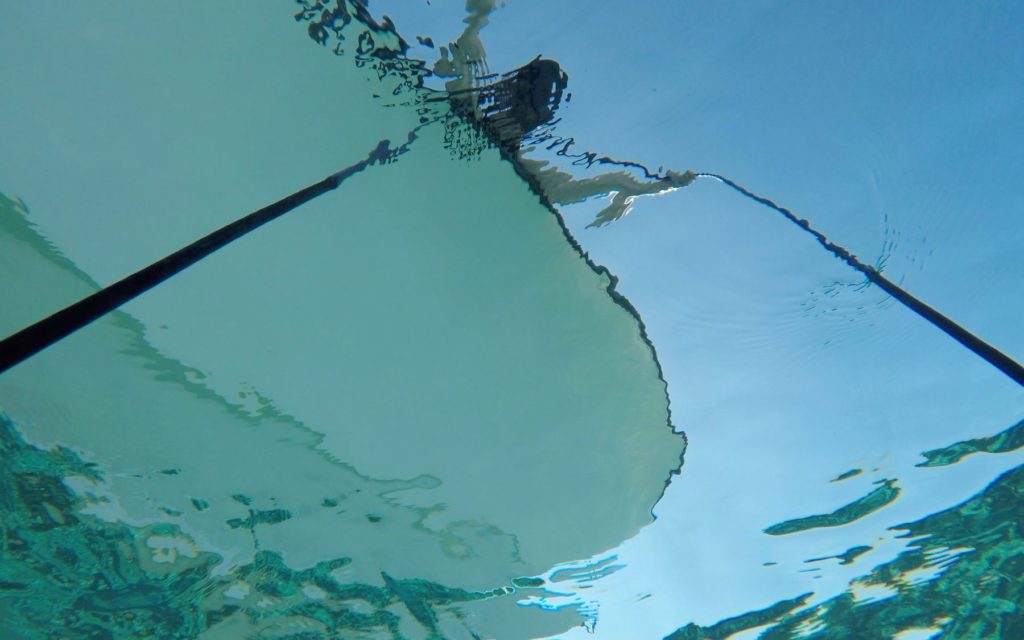
Photo of recording by Jana Winderen. Courtesy the artist and Audemars Piguet.
Really? Why am I so surprised to hear that?
TM: The surface of the water doesn’t allow sound to permeate out. And so for most of us, it’s invisible. And I think in part, this work is potent in revealing to people the complexities of sound for communication between species, between individuals, between mammals, for finding mates, for navigation, for all of the things that actually, the whole of the marine environment rely on.
One of the other artists I work with, Chris Watson, often comments on the opening lines from Jacques Cousteau documentaries, where most people were introduced to the undersea world. Costeau opened every program by saying, “I’m now entering the silent undersea world.” And that was a complete myth. It was not [silent]. He just couldn’t hear it!
What is unknown, and is often ill-considered, is the amount of sound that we put into the oceans unintentionally from jet skis, from propellers, from motors, from super tankers, and so on. If you have an idle moment, put vesselfinder.com into your browser. It gives the GPS location of all the marine traffic in the world. The sea is absolutely peppered with vessels. Some animals can adapt to that, but most animals can’t. And simple things, like propeller design and changing the mounting of engines in boats could, if we thought about it, and if we legislated for it, mitigate that.
This idea of trying to make sound more perceptible strikes me as being similar to the larger problem of climate change, which is on some level an abstract issue that people tend to not want to think about in their day to day lives. How did you start originally working in sound that had a focus on ecology?
JW: When I was a child growing up by a lake in Norway, I was very concerned with how we are treating the planet. In the early ‘70s, this lake was about to die from algae overgrowth, and it was where we got our drinking water. It was a very, very scary thing to grow up thinking that that lake would die.
In school, I wrote this essay about a fish who is traveling around the world trying to find a mate, meeting other fish like salmon who can’t find their way home to the river because of pollution or an eel who complains about oil spills. I was laughing when I found this essay again. It’s called “Henry the Herring.” I wrote it when I was 12 or 13.
I later studied to become a marine biologist—[including] chemistry, biochemistry, fish ecology—because I wanted to do research on the ocean and particularly on the mammals underwater. The question of how we are treating the planet has been a core in my life.
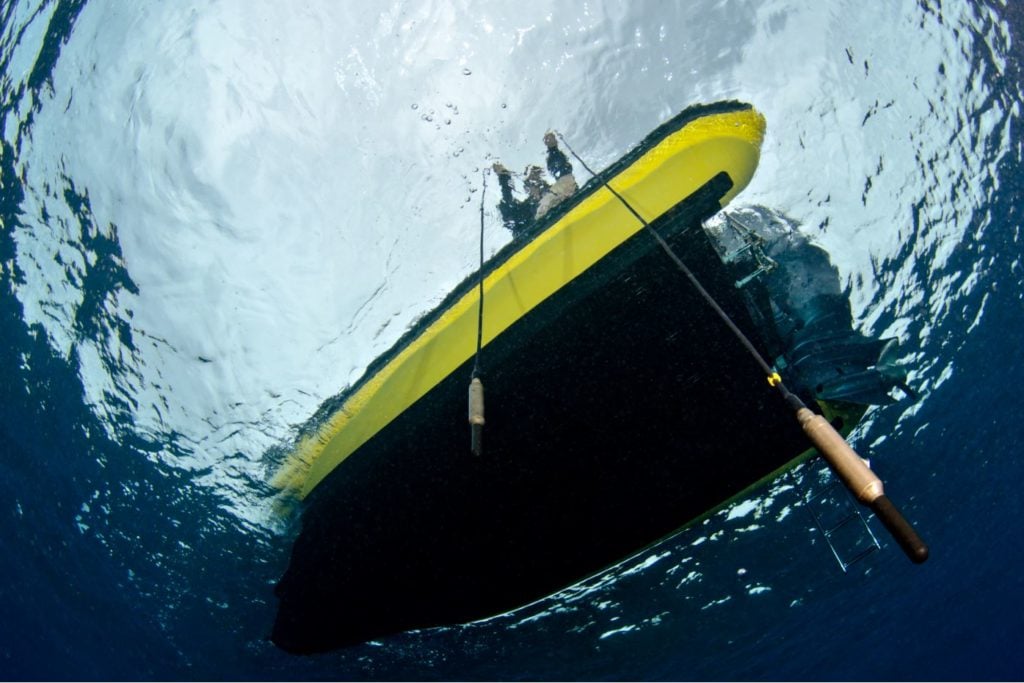
Jana Winderen recordings sounds in the Tropics. Courtesy the artist and Audemars Piguet.
It’s an understatement to say that going from marine biology into sound-based artwork is a hard pivot. How exactly did that happen?
JW: I started working with sound in about 1992. I had changed my studies, and at that point, I was drawing a lot and making physical sculptures. But conceptually, it didn’t make sense to me anymore to make objects and pile up things that would later go into a landfill. So I wanted to work with an immaterial material that didn’t take up any kind of space but is still a very physical medium.
My first [sound piece] was walking around recording the sound of the Thames. I displayed, or played back, the sound for the other students down in this dark room underneath [Goldsmiths] college, and people got scared. So I really started to think about how to present sound.
I then worked for quite some years with interactive sound, where the audience could, for example, distort the sound by the way they moved. And it was through that process that I became aware of [equipment] like the piezoelectric contact microphone, and the hydrophone [a microphone designed to capture underwater sound]. But I like to use the equipment where you’re not actually supposed to use it.
Around 2000, I used a hydrophone to start recording inside of an ant’s nest with Chris Watson. You hear all the [ants] calling around. And I also put the hydrophone inside of a tree, so you could listen to the insects down in the ground, the worms moving around, and in the sun and in ice. It’s good to challenge the tools you have.
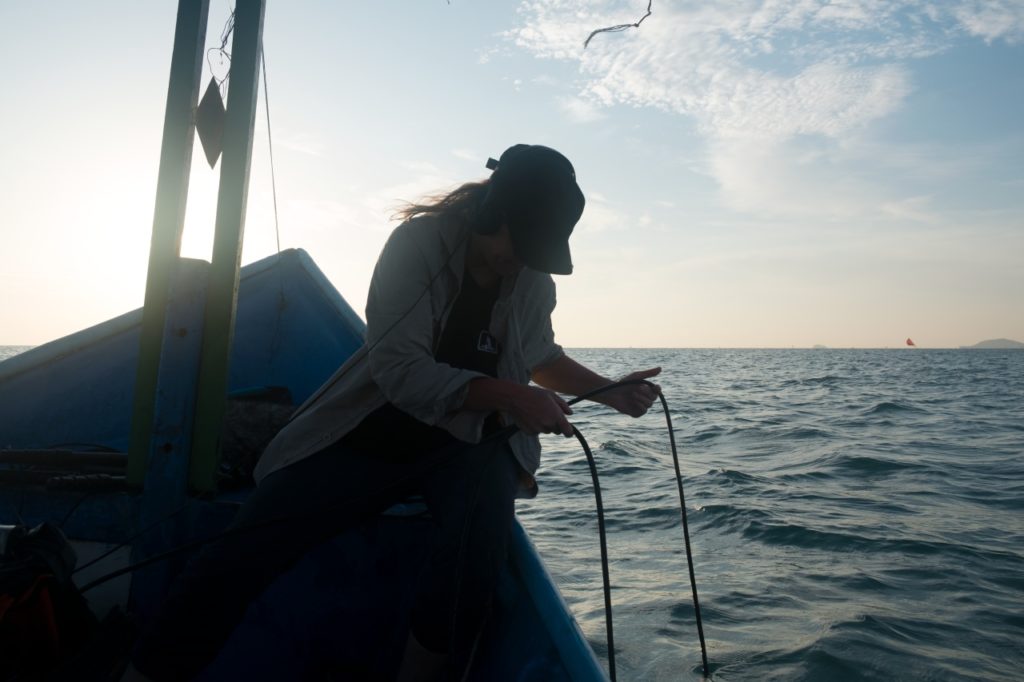
Jana Winderen recording in the Tropics. Courtesy of the artist and Audemars Piguet.
How, if at all, does that idea relate to the project you mentioned in Thailand, involving fishermen pressing oars to their heads?
JW: I met a fisherman in Thailand who told me that his granddad showed him how to listen to the sounds of crackling shrimp, barnacles, and reef areas there, with an oar to the head. He was connecting without a hydrophone. Next time you go for a swim, put your head in the water, concentrate, and listen. You can hear it, but our ears have adjusted to listening for sound traveling in air and not in water.
I think we’ve had some kind of forgetting period in the history after industrialization. We’ve forgotten even what our grandparents have told us. We need to reconnect to that knowledge, I believe.
Tony, can you speak to why you think it’s important to hear, or experience, this piece as it’s installed rather than just listening to, say, a recording on headphones?
TM: From an academic and spatial audio perspective, the installation is one of the few ways that people can really engage with full three-dimensional sound reproduction. There are sounds in this exhibition where waves are captured with ambisonic microphones that really do generate a complex wave front in front of you, and surround you with foam and splashing water. There aren’t just 10 sounds or 20 sounds there. To create this effect of a wave front crashing on the shore at your feet, there are thousands and thousands of pebbles moving and wavelets and little tiny drops, and that’s captured by a recording technique that can capture that spatial dimension.
And so it takes you to a very different sort of sonic place than one we’re quite often used to. You can’t go to the cinema to experience this. Dolby Atmos won’t do this for you, and nor will most cinema systems. You can’t hear it in the theater. You can’t see it on the TV. This is the only place you can experience this.
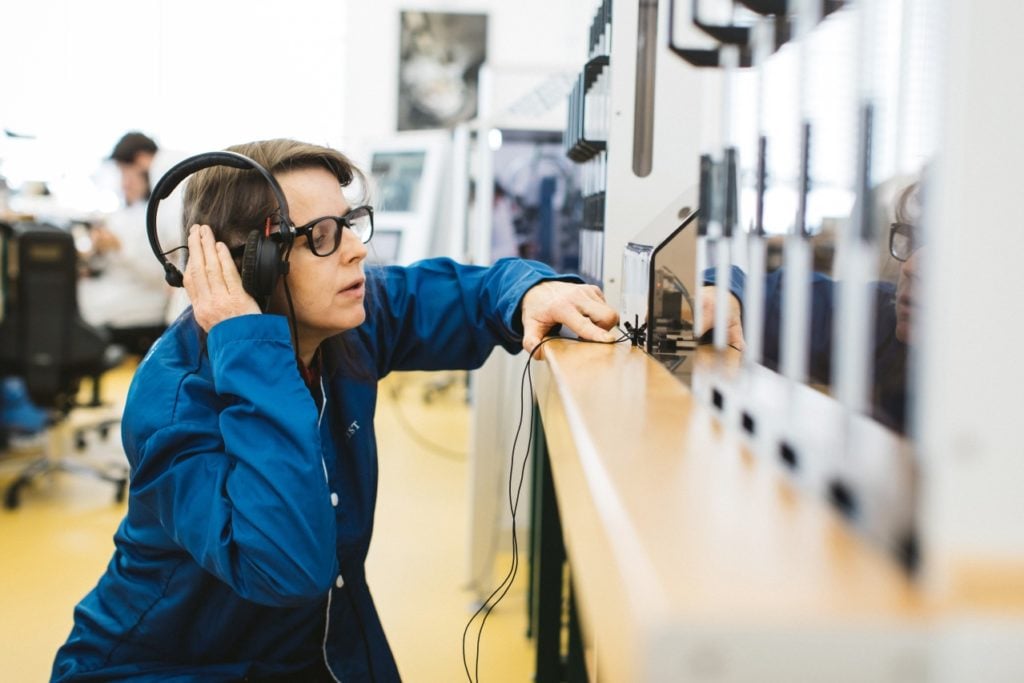
Jana Winderen recordings sounds in the Vallée de Joux. Courtesy the artist and Audemars Piguet.
I’m wondering, if there’s one thing that you hope people who come here and experience the installation would take away from it, what would it be?
JW: I am hoping they feel a heightened sensitivity to the creatures that are living underwater, and to the sound that we are putting underwater, and to how much that is actually influencing their environments.
I would also mention here that we are keeping the construction to a minimum. All the bits that we have put into the rotunda will be reused. The speakers are rented, the beanbags will be given away.
So you’re minimizing your footprint in the installation in a similar kind of way to what made you want to minimize your footprint with the work by moving into sound initially.
JW: You have to start with yourself and do what you can in this situation. It’s critical. We all need to do what we can.